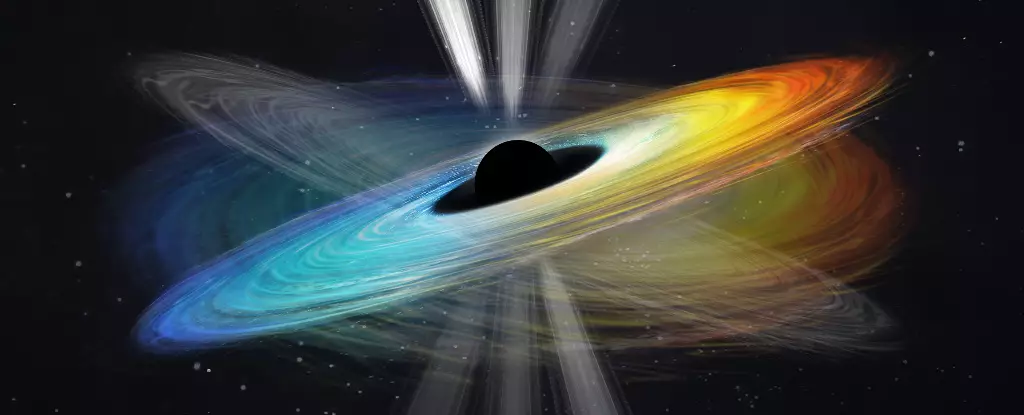In a groundbreaking endeavor to capture the first-ever image of a black hole, scientists embarked on an ambitious mission of uniting data from observatories across the planet. This massive collaborative effort resulted in a mesmerizing image that quickly made its way onto the pages of every major newspaper in 2019. Known as Messier 87, the supermassive black hole at the heart of this galaxy has continued to astound researchers. A recent analysis of observations spanning over two decades has now officially confirmed the existence of its rotation. This remarkable finding has sent waves of excitement through the scientific community, finally settling the question of whether this particular black hole is indeed spinning.
The determination to uncover the black hole’s spinning nature intensified following the groundbreaking success of capturing its image using the Event Horizon Telescope. Astrophysicist Kazuhiro Hada, a co-author of the study, expresses the significance of this discovery by stating, “Now anticipation has turned into certainty. This monster black hole is indeed spinning.” The research team meticulously analyzed 170 observations of Messier 87 taken between 2000 and 2022, utilizing a global network of more than 20 telescopes. Regrettably, due to the extreme gravitational force exerted by black holes, it remains impossible to directly observe anything within their event horizon. Even light itself is restrained within their grasp. However, scientists were able to track the awe-inspiring jet emitted by the black hole over a staggering distance of 4,900 light years. This powerful jet, appearing to move at nearly five times the speed of light, is an optical illusion known as superluminal motion. The jet was initially observed in 1918 by astronomer Heber Curtis and famously captured by the Hubble Space Telescope.
While the precise mechanisms responsible for the formation of these powerful jets continue to elude scientists, it is believed that radiation and particles are channeled along the magnetic field lines surrounding the black hole. In an intriguing development, the researchers discovered that the angle of the jet produced by the black hole at the center of Messier 87 underwent a gradual change of approximately 10 degrees before returning to its original position. This remarkable cycle occurred over the course of approximately 11 years. The team inferred the presence of a rotating black hole from this variation in the jet’s tilt. Rotating black holes possess the ability to twist the fabric of space-time in a phenomenon known as frame-dragging. This twisting motion ultimately leads to the toppling of the accretion disk and the jet itself. Cui Yuzhu, an astrophysicist and co-author of the study, emphasizes the significance of their rigorous analysis, saying, “Accumulating high-resolution data tracing M87’s structure over two decades and thorough analysis are essential to obtain this achievement.”
The proximity of Messier 87, situated a mere 54 million light-years away, renders it a captivating subject for astronomers. This remarkable proximity sets it apart from other galaxies, granting researchers a unique opportunity to delve deeper into its mysteries. Its allure has captivated stargazers for centuries, with its initial observation occurring back in 1781 by the renowned astronomer Charles Messier. Thus, we now know this galaxy as Messier 87 or M87, aptly named in honor of its discoverer.
As scientists continue to explore the marvels of the universe, they have discovered that most black holes possess an astonishing rotational speed close to that of light. In fact, previous studies have already showcased black holes rotating at incredible speeds. For instance, a black hole situated at the center of the NGC 1365 galaxy, approximately 60 million light-years away, was shown to rotate at an astounding 84 percent of the speed of light in 2013. Additionally, in 2019, scientists used X-ray pulse patterns to infer that another black hole was spinning at an astonishing 50 percent of the speed of light. An intriguing question arises: why do black holes possess such astonishingly high rotational speeds? As matter collapses into a singularity or a black hole, it becomes extremely dense, occupying a minuscule volume. However, it retains its angular momentum. If this matter originates from a rotating star, its rotational speed intensifies during the compression process, similar to the way an ice skater spins faster when they draw in their arms.
The awe-inspiring discoveries concerning spinning black holes offer fascinating insights into the extraordinary nature of the universe. With meticulous research, groundbreaking collaborations, and cutting-edge technology, scientists continue to push the boundaries of human knowledge. As we unlock the secrets of these cosmic marvels, new doors of understanding open, painting a captivating picture of the vast and enigmatic cosmos that surrounds us.


Leave a Reply